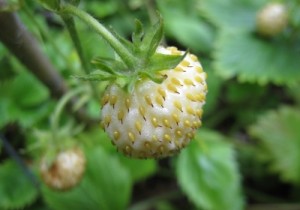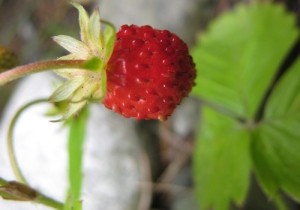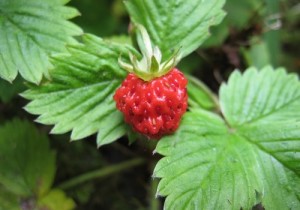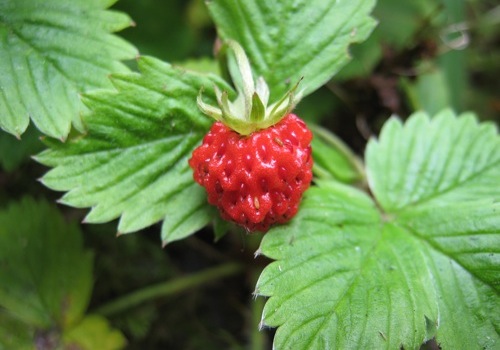Wild strawberries are an easy plant to grow – tuck them in, water them a little, and soon they will give you the daintiest, sweetest strawberries you’ve ever tasted. Plant them near your door and grab a handful for your breakfast cereal!
Arthur Lee Jacobson, Puget Sound’s edible plant expert, provides us with today’s comments on growing the Wild Strawberry (Fragaria vesca).
The original strawberry plant, so named in Europe, is a small groundcover that spreads mostly via runners and secondarily by seeds. Its berries are typically red, sweet, and prized highly as food.
In the 1700s some variants of it became known that offered larger berries and were everbearing; that is, instead of ripening a crop mainly in May and June, they kept producing until November or later. Some of these everbearing or “alpine” strawberries also formed clumps alone, with no runners.

North America has a native race or variety of Fragaria vesca, called Americana. And where I live in Seattle, the most common native variety has been named Bracteata. It is exclusively runner-bearing, May to early July ripening, sweet-tasting, and red-fruited.
In contrast, its European cousins, that are naturalized in Seattle now, can be white-berried or red-berried, with or without runners, spring-early summer ripening or perpetual-bearing, and taste sweet or bland. Also the European berries can be much larger than the American natives, and longer than wide. In brief, the Europeans are far more diverse and useful in gardens. There are many named cultivars.
The big strawberries of produce stands, are hybrids whose parentage does not include Fragaria vesca.


The way I tell apart Seattle native or European Fragaria vesca races, is by looking close at the berries. The native seeds are more or less sunk into the fruit; the European seeds are jutting out. Of course, the relative lack of diversity of the native also is a factor to use in case you observe a patch that has no ripe berries.
Perhaps the native and European will hybridize, though in my garden both have grown for decades and I have observed no intermediate offspring.
About Arthur Lee Jacobson
A lifelong Seattle resident, Arthur developed a passion for plants at 17 and has made his living growing, photographing, and writing about plants. He is a rare expert who can speak about wild plants, garden plants, and house plants.
Arthur has a special interest in edible plants, and, in his field guide Wild Plants of Greater Seattle, he includes comments on the edibility, taste, and uses of plants found in the city.
For more information, visit Arthur Lee Jacobson’s website.
Photos: ©2010, Arthur Lee Jacobson

